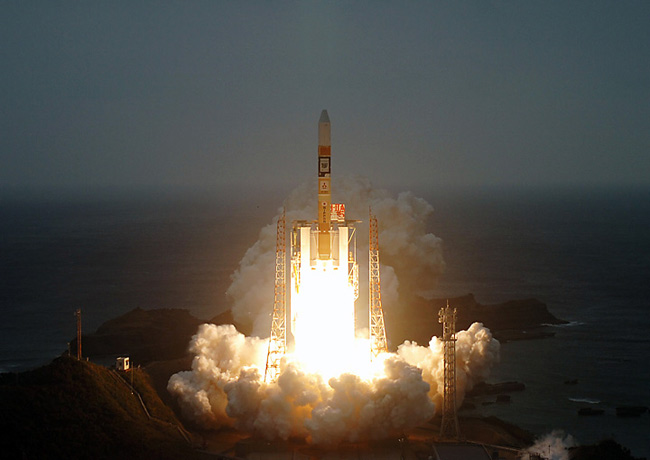Japan Launches Satellite to Track Greenhouse Gases

The first satellite devotedto measuring greenhouse gases in Earth's atmosphere arrived in space Fridayafter launching from an island spaceport in southwestern Japan.
The Greenhouse GasesObserving Satellite, or GOSAT, was deployed from the upper stage of an H-2Arocket about 16 minutes after blastoff, according to the Japan AerospaceExploration Agency.
GOSAT is also nicknamedIbuki, which means "breath" in Japanese. Scientists say greenhousegases are akin to the Earth's breath.
Greenhouse gases areproduced by natural and human sources, including geological activity,biological activity and the burning of fossil fuels.
Scientists believegreenhouse gases trapped in Earth's atmosphere are responsible for rising globaltemperatures. Carbon gases can trap heat that would normally radiate intospace, driving up the planet's average temperature, according to climate researchers.
That was the primaryimpetus behind the development of the $206 million mission.
"GOSAT is designed toobserve the global distribution of greenhouse gases, such as carbon dioxide andmethane, from space. I am convinced and excited that GOSAT will play animportant role in the understanding of global warming," said TakashiHamazaki, GOSAT project manager at JAXA.
Breaking space news, the latest updates on rocket launches, skywatching events and more!
GOSAT launched aboard anH-2A rocket from the Yoshinobu complex on Tanegashima Island at thesouthwestern tip of Japan. A hydrogen-fueled main engine and twin solid motorsboosted the 174-foot-tall rocket off the launch pad at 0354 GMT (12:54 p.m.Japanese time) Friday.
The flight was delayed twodays because of forecasted bad weather. The launch team battled thick clouds,rainy weather and cold temperatures all week, but meteorologists cleared therocket for liftoff Friday despite gusty winds and rain showers.
The first stage's LE-7Amain engine propelled the orange and white rocket to an altitude of 185 milesin the first six-and-a-half minutes of the mission. The second stage fired formore than eight minutes, honing in on a circular orbit about 425 miles high.
The upper stage wasprogrammed to release seven other smaller payloads at four-minute intervalsfollowing the separation of GOSAT.
The largest secondarypayload was a small demonstration satellite named SDS 1. The 220-pound craftcarries experimental communications equipment, a developmental data processingchip and new computer components.
Other small satellitesaboard the rocket included a collection of Japanese educational, experimentaland scientific missions. They will observe lightning, measure gamma raysemitted from Earth, test space tethers, demonstrate a new remote sensingtelescope, conduct trials of a laser ignition thruster, and help connectstudents with space.
The satellites, includingGOSAT, are circling the planet in a sun-synchronous orbit with an inclinationof about 98 degrees.
GOSAT will begin collectingscience data this spring after controllers activate and test the spacecraft'ssystems and science payload. The satellite's five-year operational mission isscheduled to begin within six months after launch.
The satellite wascommissioned by JAXA, the National Institute for Environmental Studies and theJapanese Ministry of the Environment.
"Several organizationsconduct atmospheric, oceanic and terrestrial monitoring of greenhouse gases. Toenhance these opportunities, various ministries and institutions launched aJapanese alliance for climate change observation," said Yasuhiro Sasano,director of the Center for Global Environmental Research at Japan's NationalInstitute for Environmental Studies.
GOSAT's primary objectiveis to identify sources of atmospheric carbon dioxide and methane, partly tomonitor international compliance with the Kyoto Protocol.
The Kyoto Protocol is anagreement between 37 industrialized countries and Europe to reduce greenhousegas emissions by an average of five percent, compared to 1990 levels, by 2012.The protocol was adopted in 1997 and became binding in 2005.
GOSAT's measurements willlocate areas with high greenhouse gas emission and absorption rates. Thesatellite will also track clouds of carbon dioxide spread across the globe bywind patterns.
The satellite's primaryinstrument consists of two sensors: an infrared spectrometer and a cloud andaerosol imager.
The spectrometer willobserve infrared rays of sunlight reflected from Earth back into space. Thesensor will look for the chemical signatures of carbon dioxide and methane inthe light to build a map of their worldwide concentrations.
GOSAT's imager will accountfor clouds and aerosols than can produce measurement errors.
The instrument package,called TANSO, will collect 56,000 data points of greenhouse gas densities everythree days.
Scientists now rely on lessthan 300 observation posts on the ground, ships, or aircraft to gatherinformation on greenhouse gases. Most of those locations are in Europe.
Japan plans to share datafrom GOSAT with other nations, and officials hope to begin distributinggreenhouse gas maps by 2010.
The maps will beconstructed in large sub-continental blocks depicting the regional emission andabsorption rates by both human and natural sources.
Japanese scientists areeager to partner with U.S. researchers leading the Orbiting Carbon Observatorymission, which is scheduled to launch next month aboard a Taurus rocket fromVandenberg Air Force Base, Calif.
Scientists from bothmissions have been working together since 2004, said David Crisp, OCO'sprincipal investigator.
The GOSAT and OCO teamsworked to build a common ground validation network to help combine data fromthe missions. The satellites will also fly in similar orbits to observe the samelocations at nearly the same time, officials said.
"This is particularlyimportant for this measurement because these two satellites will be making ameasurement that must be about three times more precise than other trace gasmeasurements made from space," Crisp said.
The cross-calibrationbetween OCO and GOSAT will improve confidence that both satellites are makingaccurate measurements.
OCO's spectrometer willprovide greater sensitivity on carbon dioxide measurements but is unable todetect methane. GOSAT's orbit is designed to bring the satellite over the samelocation more often, allowing the craft's lower resolution instrument to createa new global map every three days.
"Together, OCO andGOSAT provide independent measurements that will help scientists betterunderstand this important greenhouse gas and its impacts on our present andfuture climate," Crisp said.
- Images - 20 Great Rocket Launches
- Video - SpaceX?s Falcon 1 Rocket Success!
- Top 10 Emerging Environmental Technologies
Copyright 2009 SpaceflightNow.com,all rights reserved.
Stephen Clark is the Editor of Spaceflight Now, a web-based publication dedicated to covering rocket launches, human spaceflight and exploration. He joined the Spaceflight Now team in 2009 and previously wrote as a senior reporter with the Daily Texan. You can follow Stephen's latest project at SpaceflightNow.com and on Twitter.
